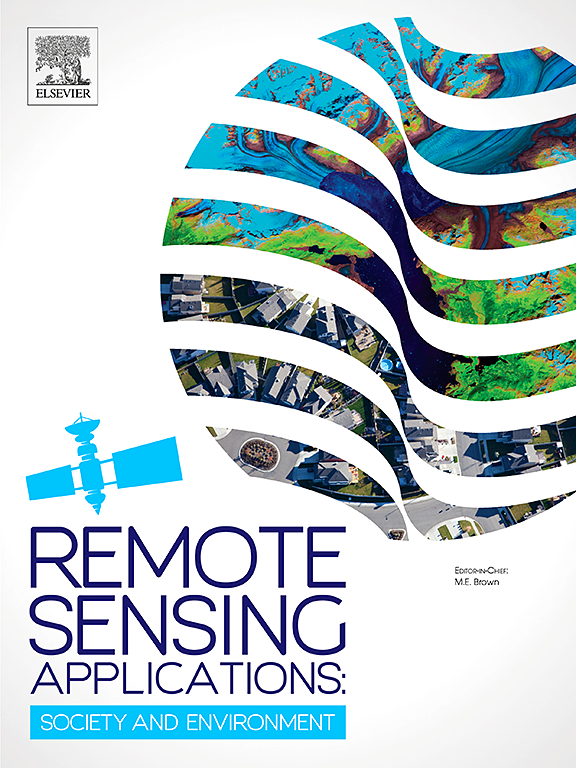Ver ítem
- xmlui.general.dspace_homeCentros e Institutos de InvestigaciónCIRN. Centro de Investigaciones de Recursos NaturalesInstituto de Recursos BiológicosArtículos científicosxmlui.ArtifactBrowser.ItemViewer.trail
- Inicio
- Centros e Institutos de Investigación
- CIRN. Centro de Investigaciones de Recursos Naturales
- Instituto de Recursos Biológicos
- Artículos científicos
- Ver ítem
Non-monotonic vegetation activity trends in the Lower Delta of the Paraná River: masking evidence of wetland degradation?
Resumen
To understand the consequences of unsustainable management practices and global change, analyzing the patterns of ecosystem functioning and land degradation is as important as quantifying the spatio-temporal patterns of land cover loss. This is particularly important for wetlands where loss and degradation are globally intensifying. In the Lower Delta of the Paraná River, Argentina, land use change has occurred in the context of cattle raising
[ver mas...]
To understand the consequences of unsustainable management practices and global change, analyzing the patterns of ecosystem functioning and land degradation is as important as quantifying the spatio-temporal patterns of land cover loss. This is particularly important for wetlands where loss and degradation are globally intensifying. In the Lower Delta of the Paraná River, Argentina, land use change has occurred in the context of cattle raising intensification, which involves water management infrastructure. However, when those changes specifically occurred and whether they permanently influenced the functional component of wetland ecosystems remain unanswered. We used a long-term (2001–2015) fused satellite-derived Normalized Difference Vegetation Index dataset to identify major shifts in vegetation activity trends using the Breaks for Additive Seasons and Trend algorithm. We assembled a set of hydro-climatic, environmental, and anthropogenic variables to study their association with the spatio-temporal patterns of vegetation activity trends. Our results show that browning-to-greening trends dominated throughout the study area. Concomitantly, the magnitude of breakpoints was mainly negative, which points towards rapid land degradation and biomass submersion or removal events. Breakpoints primarily occurred between 2007 and 2009 and were partially coincident with an extraordinary flood event and intentional fire outbreaks. Paranacito river flooding, precipitation, the synchronicity with temperature patterns, water management infrastructure and the occurrence of local land cover conversions were determining factors in the differentiation and characteristics of vegetation activity trends, shifts and breakpoints. Our results provide evidence that even though regional hydro-climatic patterns remain as main drivers of wetland vegetation dynamics, human influence and its negative effects increase in the context of adverse hydro-climatic scenarios. In this matter, we observed that the decouplement from the flood pulse promoted a post-disturbance recolonization of herbaceous vegetation. Consistently, the widespread browning-to-greening trend reversal does not necessarily relate to wetland vegetation recovery but instead, might have masked its extensive conversion to grasslands.
[Cerrar]

Autor
Aquino, Diego Sebastián;
Sica, Yanina Vanesa;
Quintana, Rubén Darío;
Gavier Pizarro, Gregorio Ignacio;
Fuente
Remote Sensing Applications: Society and Environment, 24 : 100626 (November 2021)
Fecha
2021-09-14
Editorial
Elsevier
ISSN
2352-9385
Documentos Relacionados
Formato
pdf
Tipo de documento
artículo
Proyectos
(ver más)
INTA/PNNAT-1128052/AR./Desarrollo de herramientas y validación de metodologías para el estudio, gestión y manejo de los sistemas productivos, contribuyendo a su resiliencia socio agroambiental.
Palabras Claves
Derechos de acceso
Restringido
 Excepto donde se diga explicitamente, este item se publica bajo la siguiente descripción: Creative Commons Attribution-NonCommercial-ShareAlike 2.5 Unported (CC BY-NC-SA 2.5)
Excepto donde se diga explicitamente, este item se publica bajo la siguiente descripción: Creative Commons Attribution-NonCommercial-ShareAlike 2.5 Unported (CC BY-NC-SA 2.5)

